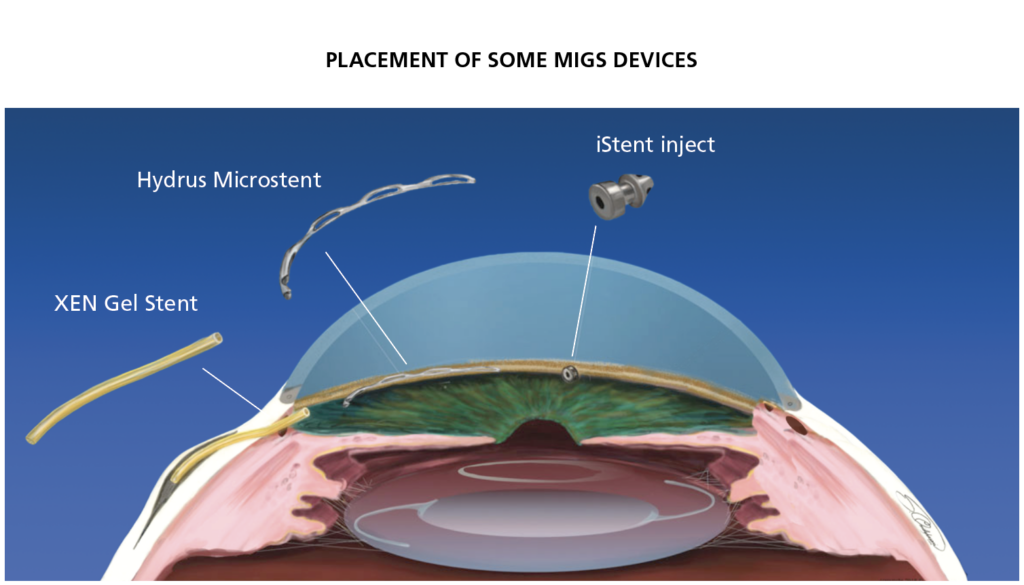MIGS
Minimally Invasive Glaucoma Surgery (MIGS) procedures have been developed in recent years to treat patients earlier and more safely than conventional surgery. As with all new procedures, multi-year follow-up studies are required to see which ones will remain useful long-term.
MIGS procedures include microsurgical instruments and devices and smaller incisions that manipulate the eye tissues less and therefore reduce the risk of complications. The increased safety of these surgeries is traded for reduced effectiveness.
MIGS procedures and devices may work in a number of ways. Some enhance fluid outflow within the eye’s drainage system, some carry fluid to the outside of the eye. Some types of MIGS procedures are to be done only with cataract surgery, whereas other MIGS procedures can be performed independent of cataract surgery.
Cataract surgery alone lowers pressure, and the combination of a MIGS surgery and cataract surgery can lower pressure more to help reduce the need for medication. Implanting a MIGS device adds a few minutes to cataract surgery.
The MIGS group of devices and surgeries are divided into categories according to how they work:
- Miniaturized versions of trabeculectomy: In these procedures, tiny tubes are inserted into the eye to help drain fluid from inside the eye to underneath the outer membrane of the eye (conjunctiva). These procedures include the XEN Gel stent, which is FDA approved and the PRESERFLO (formerly InnFocus) MicroShunt which is available outside the US.
- Angle-based surgeries: In these procedures, specialized instruments and devices are used to modify the eye’s drainage canals (trabecular meshwork, Schlemm’s canal, and collector channels) and improve the drainage of fluid from the eye. These procedures involve cutting through the trabecular meshwork (e.g., Trabectome, Kahook Dual Blade, OMNI Surgical System), bypassing the trabecular meshwork by placing a stent in the Schlemm’s canal (e.g., iStent Inject, Hydrus Microstent), and expanding the Schlemm’s canal and collector channels with a gel (e.g., iTrack, OMNI Surgical System). Different angle-based MIGS procedures can be combined in various ways in order to increase drainage of fluid from the eye.

Conventional surgeries for glaucoma include trabeculectomy or aqueous shunts (see below). While they can be more effective at lowering eye pressure and preventing progression of glaucoma, they also have more potential complications.
Who is a good candidate for MIGS procedures?
For angle-based MIGS, the best candidates are those with mild to moderate primary open-angle glaucoma (POAG). Other candidates include those who have side effects to medical therapy, or those who have undergone other procedures and still have elevated eye pressures.
Who performs MIGs procedures?
Ophthalmologists, particularly glaucoma specialists, provide MIGS as part of a number of treatment options available to their patients.
How do MIGS procedures compare with traditional glaucoma surgery?
When compared to traditional glaucoma surgeries such as trabeculectomy and aqueous drainage devices, MIGS procedures have lower efficacy but an improved safety profile. For most patients with mild to moderate glaucoma, the MIGS procedures provide adequate IOP lowering while reducing the risk of the potentially severe complications associated with traditional glaucoma surgeries.
Thank you to Regine Pappas, MD for contributing to this article.
